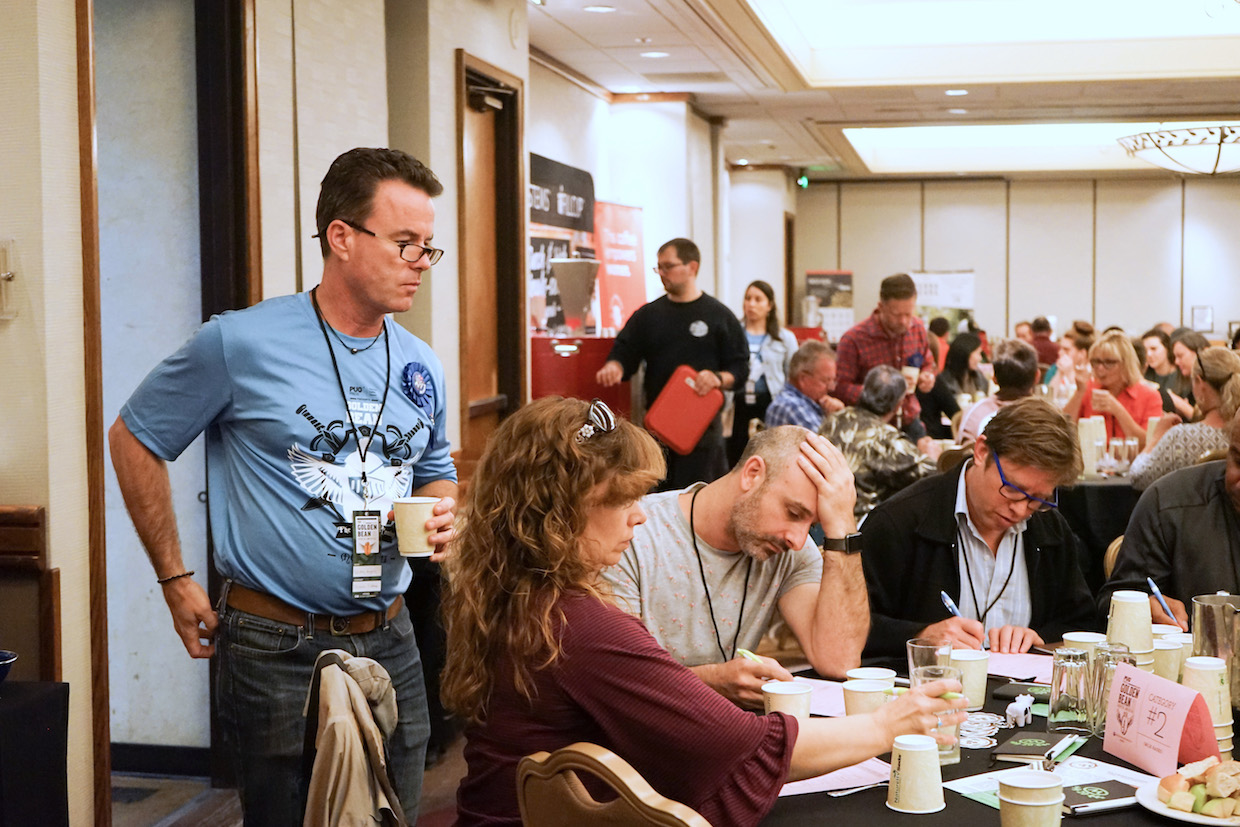
Judging at the 2019 Golden Bean North America roasting competition last month in Portland, Oregon. Photo by Howard Bryman/Daily Coffee News.
With scores of roasters huddling together to taste hundreds of coffees at the recent Golden Bean roasting competition in Portland, DCN seized the golden opportunity to ask a few questions — pulling the trier, as it were, from a drum full of thoughts and perspectives from professional coffee roasters.
We asked the same five questions of six different roasters representing four different corners of the USA and one from Australia, of experience levels from relatively new to seasoned, award-winning industry veterans. They are:
Adrian Capra of Art of Espresso, based in New South Wales, Australia
- Roasting experience spans 15 years
- Currently roasts on a Diedrich IR24 (transitioning to an IR30)
Brandon Bir of Crimson Cup Coffee, based in Columbus, Ohio
- Roasting experience spans 5 years
- Currently roasts on two Probat L12’s, one 60-pound-capacity machine made in Spain, and a two-barrel Probat sample roaster.
Emily Smith of World Cup Coffee, based in Portland, Oregon
- Roasting experience spans 6 months on a production-size machine and several years of sample roasting
- Currently roasts on a Diedrich IR-12
Deaton Pigot of Tectonic Coffee, based in Los Angeles, California
- Roasting experience spans 13 years
- Currently roasts on a 12-kilo Joper and an Ikawa sample roaster.
Calvin Patching of Five Rivers Coffee Roasters, based in Tillamook, Oregon
- Roasting experience spans 1.5 years
- Currently roasts on a 25-kilo Toper
Scotty Angelo of Oceana Coffee, based in Tequesta, Florida
- Roasting experience spans 9 years
- Currently roasts on a Giesen W15
For our first inquiry, we asked about each roaster’s most challenging bean. For our second question, we asked:
What is your favorite piece of technology that you work with regularly, and in what specific ways do you leverage technology in the course of your work?
Scotty Angelo: The Giesen roaster has got to be my favorite piece of equipment. Pieces of equipment that I’m looking to get my hands on: Javalytics, to better analyze the full roast spectrum, where I can test a whole bean versus a ground to tell me where’s my development at within the bean, I think that’s where I’d like to be.
Calvin Patching: Currently I’m using Artisan, for the Toper machine. We’ve got it hooked up to it and got bean temp, exhaust temp, I think that’s definitely my favorite bit of technology. I’m working into it and hoping to get into it more. It’s cheap, it’s free, and I used to do it by hand, on paper, so having it be able to graph all my roasts is huge. I love that.
Adrian Capra: It’s my Slayer coffee machine, hand-built in Seattle. You can tune the profile to an origin or a blend, right down to if you want more acidity, if you want more body. You can get the grind so fine, lift the sugar profile. There’s so much you can do with your coffee. Roasting is a pleasure, I enjoy my IR-24… the roaster you can tweak, but I have to have patience before I drink it, whereas when it’s ready to drink, my Slayer is my go-to piece of equipment. At the end of the day, it’s the final link in a long chain from plant to cup, and that there is how it all ends up.
Brandon Bir: We’re playing a lot with ultraviolet lights. We use a low wave and high wave. We can look at it both ways, and I think they both give you different different things. We’re trying to identify if there are defects… It’s inconclusive so far because we don’t have that big of a sample size, and it takes so much work to actually pick by hand, piece by piece. But at the same time it’s been it’s made us dive a little bit deeper into the coffee and look more at the details.
…You don’t really think about that kind of stuff too often unless you’re at origin working with a producer, which happens once every couple months. It’s nice to take green coffee home and try to analyze it, come up with solutions and innovate a little bit. I think there’s a hundred different things that you could focus on inside a coffee, and this is just one extra thing to look at, to see if we can mitigate risk of bringing in bad coffee.
Deaton Pigot: It has to be Cropster. It’s all-encompassing for us. It handles all our inventory, all our roast data and reporting, cupping scores, the whole nine yards.
Emily Smith: I’m a very analog person. My technology that I use is legitimately a timer with three buttons on it. I have a pen and a piece of paper. That’s what I use to track everything.
Howard Bryman
Howard Bryman is the associate editor of Daily Coffee News by Roast Magazine. He is based in Portland, Oregon.






Comment